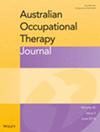How spirituality is understood in occupational therapy: A qualitative study
Abstract
Introduction
Since the inception of occupational therapy, spirituality has been a unique component of practice. However, much of the professional discourse on how to define spirituality has originated internationally. This study aimed to explore how Australian occupational therapists interpret and understand spirituality in their practice.
Methods
This study employed an interpretive phenomenological methodology and reflexive thematic analysis. Twenty-three individual interviews were conducted with Australian occupational therapists across various work and specialty contexts.
Consumer and community involvement
Because the participants in this study were occupational therapists, the research design did not include input from consumers or the community.
Findings
Three main themes emerged from this study: (i) definitions of spirituality were complex and often described a person's connection to meaning and purpose in life; (ii) human factors that supported addressing spirituality included therapist self-reflection and clinical experience, while therapist discomfort and specific client circumstances acted as barriers; and (iii) environmental factors that supported addressing spirituality included access to training and a supportive workplace, while barriers included cultural taboos, as well as time and funding limitations.
Conclusion
All occupational therapist participants acknowledged spirituality as the meaningful connection between one's inner self and the outer world, and for most participants, this included acknowledging the transcendent. Therapist skills that facilitated the integration of spirituality into practice included self-reflection and building rapport with clients, which therapists could control. However, factors like years of clinical experience were beyond their control. In terms of environmental factors, therapists could influence their access to spirituality training, but aspects like a supportive work environment were often outside their influence. Additionally, many therapists reported feeling uncomfortable discussing spirituality within what they considered to be a culturally closed local context. To help overcome these challenges, the occupational therapy profession could benefit from developing culturally sensitive spirituality resources, research, and training.
PLAIN LANGUAGE SUMMARY
Spirituality has always been a part of occupational therapy, but much of the talking about it comes from other countries. This study looked at how Australian occupational therapists see spirituality. We interviewed 23 occupational therapists from all different jobs. They all agreed that spirituality is about connecting a person's inner self with the world. While therapists could control things like self-reflection and building relationships with clients, their years of clinical experience was outside their control. Likewise, they may be able to look for further education, but a supportive work environment was often out of their hands. Many therapists also felt uncomfortable discussing spirituality in workplaces where it was not openly accepted. To face these challenges, the profession may need more resources, research, and training on spirituality in practice.


 求助内容:
求助内容: 应助结果提醒方式:
应助结果提醒方式:


